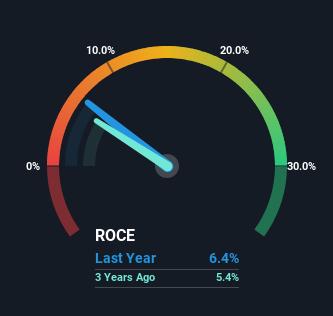- China
- /
- Electrical
- /
- SHSE:603618
Hangzhou Cable (SHSE:603618) Has Some Way To Go To Become A Multi-Bagger

Did you know there are some financial metrics that can provide clues of a potential multi-bagger? Firstly, we'd want to identify a growing return on capital employed (ROCE) and then alongside that, an ever-increasing base of capital employed. Put simply, these types of businesses are compounding machines, meaning they are continually reinvesting their earnings at ever-higher rates of return. However, after investigating Hangzhou Cable (SHSE:603618), we don't think it's current trends fit the mold of a multi-bagger.
Return On Capital Employed (ROCE): What Is It?
If you haven't worked with ROCE before, it measures the 'return' (pre-tax profit) a company generates from capital employed in its business. Analysts use this formula to calculate it for Hangzhou Cable:
Return on Capital Employed = Earnings Before Interest and Tax (EBIT) ÷ (Total Assets - Current Liabilities)
0.064 = CN¥287m ÷ (CN¥11b - CN¥6.3b) (Based on the trailing twelve months to June 2024).
Thus, Hangzhou Cable has an ROCE of 6.4%. Even though it's in line with the industry average of 5.9%, it's still a low return by itself.
View our latest analysis for Hangzhou Cable

Historical performance is a great place to start when researching a stock so above you can see the gauge for Hangzhou Cable's ROCE against it's prior returns. If you're interested in investigating Hangzhou Cable's past further, check out this free graph covering Hangzhou Cable's past earnings, revenue and cash flow.
The Trend Of ROCE
There are better returns on capital out there than what we're seeing at Hangzhou Cable. Over the past five years, ROCE has remained relatively flat at around 6.4% and the business has deployed 28% more capital into its operations. Given the company has increased the amount of capital employed, it appears the investments that have been made simply don't provide a high return on capital.
Another point to note, we noticed the company has increased current liabilities over the last five years. This is intriguing because if current liabilities hadn't increased to 58% of total assets, this reported ROCE would probably be less than6.4% because total capital employed would be higher.The 6.4% ROCE could be even lower if current liabilities weren't 58% of total assets, because the the formula would show a larger base of total capital employed. So with current liabilities at such high levels, this effectively means the likes of suppliers or short-term creditors are funding a meaningful part of the business, which in some instances can bring some risks.
The Bottom Line On Hangzhou Cable's ROCE
Long story short, while Hangzhou Cable has been reinvesting its capital, the returns that it's generating haven't increased. Unsurprisingly then, the total return to shareholders over the last five years has been flat. In any case, the stock doesn't have these traits of a multi-bagger discussed above, so if that's what you're looking for, we think you'd have more luck elsewhere.
On a final note, we found 2 warning signs for Hangzhou Cable (1 makes us a bit uncomfortable) you should be aware of.
If you want to search for solid companies with great earnings, check out this free list of companies with good balance sheets and impressive returns on equity.
If you're looking to trade Hangzhou Cable, open an account with the lowest-cost platform trusted by professionals, Interactive Brokers.
With clients in over 200 countries and territories, and access to 160 markets, IBKR lets you trade stocks, options, futures, forex, bonds and funds from a single integrated account.
Enjoy no hidden fees, no account minimums, and FX conversion rates as low as 0.03%, far better than what most brokers offer.
Sponsored ContentValuation is complex, but we're here to simplify it.
Discover if Hangzhou Cable might be undervalued or overvalued with our detailed analysis, featuring fair value estimates, potential risks, dividends, insider trades, and its financial condition.
Access Free AnalysisHave feedback on this article? Concerned about the content? Get in touch with us directly. Alternatively, email editorial-team (at) simplywallst.com.
This article by Simply Wall St is general in nature. We provide commentary based on historical data and analyst forecasts only using an unbiased methodology and our articles are not intended to be financial advice. It does not constitute a recommendation to buy or sell any stock, and does not take account of your objectives, or your financial situation. We aim to bring you long-term focused analysis driven by fundamental data. Note that our analysis may not factor in the latest price-sensitive company announcements or qualitative material. Simply Wall St has no position in any stocks mentioned.
About SHSE:603618
Hangzhou Cable
Engages in the research, design, development, manufacture, and sale of wires, cables, and optical fiber cables in China and internationally.
Low with questionable track record.
Market Insights
Community Narratives



